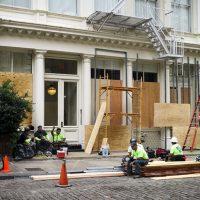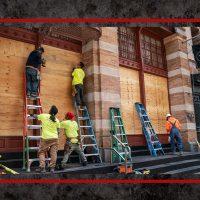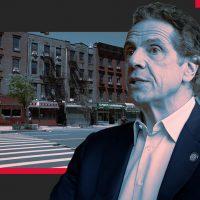Welcome to Plywood City. Grand opening is in four days.
With the Big Apple’s scheduled reboot nearly at hand, banners, balloons and ribbons are nowhere to be found. Instead, boarded-up storefronts mar the landscape and an evening curfew remains in place.
But the show will go on, according to Gov. Andrew Cuomo. “New York City enters phase one Monday,” he declared Thursday at his daily coronavirus press conference.
In an earlier radio interview, the governor had intimated that the June 8 reopening was not a certainty, given the nightly looting that has swept across the borough since Sunday. It remains uncertain. At any time Cuomo could push back the return of nonessential businesses if he deems the city — battered for three months by the coronavirus and for days by clashes between police and police-brutality protesters — unready.
“With all this going on, New York City had the highest number of protesters,” the governor said, referring to demonstrations nationwide in the aftermath of George Floyd’s death at the hands of Minneapolis police.
Read more



Mayor Bill de Blasio, meanwhile, was looking for good news to announce before his mayoralty is damaged beyond repair. He unveiled a plan Thursday for outdoor dining, although it will not begin until reopening’s phase two, which could be as soon as June 22 if certain health benchmarks are reached.
“Our “Open Restaurants” plan will help these businesses maximize their customer base while maintaining the social distancing we need to beat this crisis once and for all,” de Blasio said in a statement.
Picking up an initiative spearheaded by the City Council and dreamed of by anti-car activists for years, the mayor will allow restaurants to convert parking spaces to use for dine-in service. No hated inspectors from city agencies, either: The mayor promised a simple online process to register and self-certify.
His press release Thursday said restaurants cannot put seating in bus stops, by fire hydrants or near intersections, and must provide their own barricades, planters, tables and chairs.
Restaurants — of which there were more than 27,000 citywide before the mayor and governor limited them to take-out service in mid-March — have complained for years that it takes several months or more to get a sidewalk cafe approved.
“In addition to dealing with the immediate crisis, we should be thinking long term about how do we streamline and expedite the process,” said Andrew Rigie, executive director of the New York City Hospitality Alliance, a trade group for restaurants, bars and clubs. “Perhaps through this process they learn ways they can be more nimble.”
Advocates for repurposing streets were ecstatic.
“Our streets must be a pathway to New York City’s recovery and not solely dedicated to traffic and parking,” said Danny Harris, executive director of Transportation Alternatives, which no doubt will press for the policy to continue as long as possible, if not forever.
As Liam Blank of Tri-State Transportation Campaign said in a statement released by the mayor, “This is also a moment to rethink street space writ large.”
Rigie would not hazard a guess as to how many eateries will survive the pandemic, but said the U.S. Senate’s passage Wednesday night of a far less restrictive Paycheck Protection Program will help tremendously, assuming the president signs the measure.
It remains to be seen if government officials in New York will see reopening as a remedy to recent unrest or a casualty of it. The first night of the city’s curfew, Monday at 11 p.m., coincided with the worst of the looting, although many observers saw the NYPD’s poor deployment and lackluster response as greater factors.
On Tuesday, curfew was pushed up to 8 p.m. and the city shut down evening service by Uber, Lyft, and Citibike, as well as banned nonessential vehicles below 96th Street. That made it challenging for looters to abscond with high-end merchandise as they appeared to do with impunity Monday night.
In one scene, looters parked on West 32nd Street, near Macy’s Herald Square flagship, and stuffed goods into the vehicle, then — unbothered by police — returned to the crime scene for a second helping. Cops did make about 400 arrests that night.
Monday’s mayhem prompted Cuomo to slam the NYPD and muse about removing de Blasio from office. On Thursday, noting the ransacking of mom-and-pop stores in distressed communities, he said, “I am saying to the district attorneys they should take these looters and punish them for what they did.”
